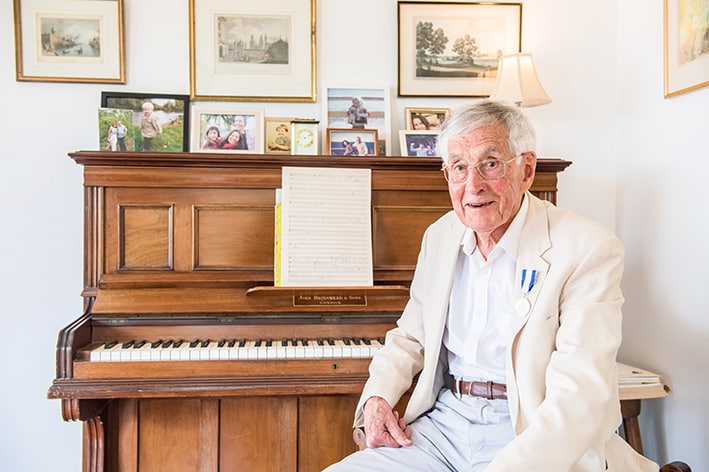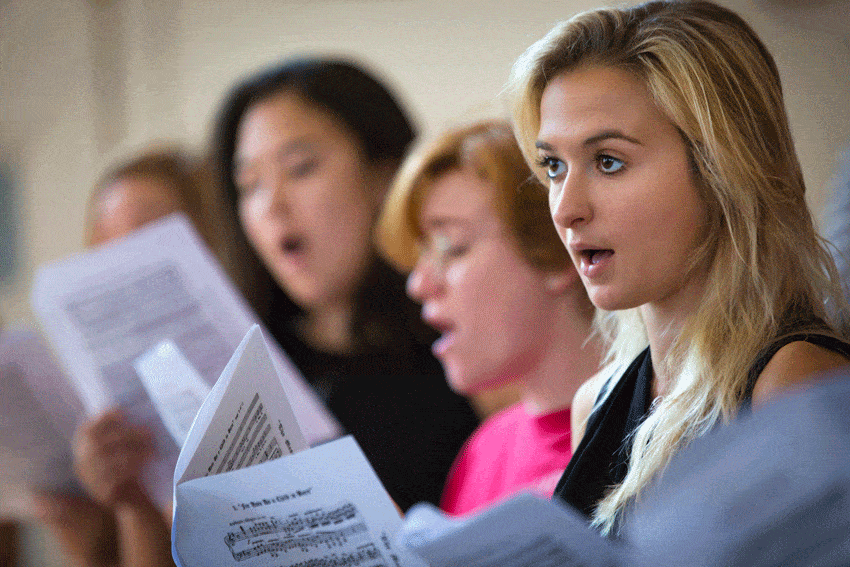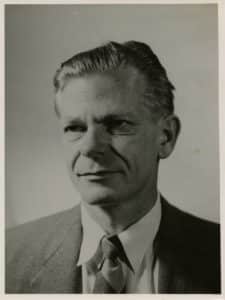
A tribute to iconic composer: Richard Connolly. Part 1
By Richard Pennington
As a composer of music, Richard Connolly provided entertainment for generations of young children by writing the theme song for the ABC production, Play School: “There’s a bear in there …” It was one of many pieces he would write for the ABC in the course of his long career there in various capacities, ultimately becoming Head of Drama and Features.
Famous though the song is, Richard’s finest achievements as a composer lie in the field of sacred music. His output in that regard was varied, reflecting both his classical training as an organist and his life-long admiration for jazz. He was well known for his congregational Mass settings, which included Missa Pax et bonum, Common things divinely, and Our Lady, Help of Christians. The latter remains in print to this day. However, his greatest contribution to sacred music was his hymnody.
The year 1963 saw the publication of Hymns for the Year of Grace, which contained 12 hymns for the church year, written by Richard to the words of the poet and editor of Quadrant, Professor James McAuley. 1964 saw the release of an LP recording, and the publication of the red-covered accompaniment book for the Living Parish Hymn Book.
The latter contained the music and words of a number of other hymns by Richard, together with some from his collaboration with McAuley, and many traditional Catholic hymns. It had been preceded by the publication in 1960 of the Living Parish Hymn Book itself, which contained the words to the various hymns, and grew out of the Living Parish movement, a group of enthusiastic Catholics founded by Fr Roger Pryke of Camperdown parish, Sydney, who met weekly.
“Of McAuley’s words generally, he said, ‘It seemed like they wrote their own tunes, … they were such wonderful words.’”
The collaboration between Connolly and McAuley had commenced in 1955, when Fr Ted Kennedy introduced them at dinner. Fr Kennedy was then the curate of Richard’s parish at Ryde, and would later become famous for his work with indigenous people at Redfern parish.
He brought with him a copy of the psalms of Joseph Gelineau, and the words of Help of Christians, guard this land. All three introductions had a profound effect on Richard.
McAuley’s poetry would inspire him to begin the most prolific period of hymn writing in his life.
In an interview with ABC Radio on 22 June 2003, he told of his excitement at receiving McAuley’s words for Song of Cosmic Praise in the mail one morning and conceiving the tune during his car journey to work. Of McAuley’s words generally, he said, “It seemed like they wrote their own tunes, … they were such wonderful words.”
Gelineau had introduced to post-war Europe the congregational singing of responsorial psalms in the vernacular. His example would inspire Richard to expand the use of the sung vernacular at Mass to hymnody of his own. The words of Help of Christians stirred him to write a magnificent tune, Camilla, which would later come to be regarded by many as the battle cry of the DLP movement inspired by BA Santamaria.

The LPH itself quickly became a staple of Catholic parishes throughout the nation. Its success ensured that Richard’s hymns were taught to and sung by generations of Catholic schoolchildren and parishioners. Many would later be republished in the hymn books that succeeded the LPH, such as the Catholic Worship Book (1985), Gather Australia (1988) and As One Voice (1992). They continue to be sung in parishes to this day, particularly in his own parish of Manly-Freshwater at the Church of Mary Immaculate and St Athanasius, Manly.
The significance of Richard’s contribution to Australian hymnody is best appreciated by considering the way in which Mass was celebrated in the 1950’s and 1960’s.
In those days, it was celebrated in Latin according to the Tridentine rite, mainly by the celebrant and altar servers. Apart from the readings, little was said in English. Hymns filled the gap by providing sung prayers in the vernacular, which not only could be understood by the congregation, but uttered by them, usually with organ accompaniment. This permitted active participation in the Mass.
“Full, conscious and active participation” by the faithful would later become the catch cry and imperative of the reforms of Vatican II, famously enshrined in Sacrosanctum Concilium (1963, Ch II, art 14), but the desire for it had its origins in the Tridentine Mass itself, attended by an ever more educated, affluent and enthusiastic post-War generation of Catholics. Before the reforms, it fell to hymnodists like Richard to provide an opportunity for this active participation. It is no wonder that his hymns quickly became a popular, important and almost ubiquitous aspect of Catholic worship.
“Richard had an unusual gift for flowing and mellifluous melody, which in its best examples recalls the lilting nature of traditional Irish song.”
Richard’s concentration on providing music for congregations, rather than for skilled soloists, ensembles or choirs, readily distinguishes his output from that of many other writers of sacred music, and has its genesis in the Latin Mass, which dominated his formative years as a Catholic.
Richard’s tunes reflected a variety of influences. He thoroughly absorbed the regularly mensurate, almost march-like ‘four square’ style which derived from the German chorales of the 16th and 17th centuries such as Nun danket alle Gott (‘Now thank we all our God’), probably through such traditional Catholic hymn tunes as Sweet Sacrament Divine (Fr F Stanfield, 1834-1915), the Irish tune St Columba (‘O breathe on me, breath of God’, in triple time), Anima Christi (‘Soul of my saviour’ by Fr Maher SJ, 1823-77) and the traditional Italian tune to which We stand for God is sung in Australia.
All were published in the LPH alongside his own work. Examples of this style in Richard’s settings can be found in Praise to the Father and to the Son (North Ryde), Father we praise you (Sandy Bay), Seek, O seek the Lord (Venantius), Help of Christians, guard this land (Camilla), May this Lenten discipline (Lindfield), By your kingly power (Ruggiero), By your priestly power (Travalli), and Holy Father, God of might (Catherine).
Richard had an unusual gift for flowing and mellifluous melody, which in its best examples recalls the lilting nature of traditional Irish song. Among the most poignant are his settings of Where there is charity and love (Jeremy) and Jesus, in your heart we find (Sancta Sophia).

The latter appears to have been named in honour of Sancta Sophia College at the University of Sydney. Sancta Sophia is situated between St John’s College and the parish church at Camperdown, and was the venue for a famous series of lectures conducted by Fr Pryke on the changes that were occurring in the Church in the 1960’s.
Like other Catholic composers, Richard was strongly influenced by Gregorian chant. He had been introduced to the Church modes by his music teacher, the Spanish priest Fr Muset, while studying at Springwood seminary. Many of his hymns are frank essays in the Dorian mode, sometimes even adopting irregular rhythms like the chant itself: In your motherhood, O Mary (Minto), In our sorrow we seek for joy (St Charles), Light of our darkness (Christopher), Help of Christians (Camilla), Come, O Jesus (New Town), and All you people praise the Lord (Antony).
Perhaps the most remarkable of these was O Jesus crucified (Forbes St), set to McAuley’s words. Unlike any other of Richard’s hymns, the tune is underlaid with a dirge-like repetition of two chords throughout, giving it the sound of a march, as if the early Christians were surging forward into history after surviving persecution.
This, together with its triumphant and dramatic modulation from the minor to the major key in the last two verses, recalls the flavour of such ‘leather-and-metal’ Cecil B DeMille classics as Quo Vadis, King of Kings and Ben-Hur. Its popularity over many decades doubtless reflected the television-viewing tastes of 20th century congregations.
Richard’s specialisation in music for congregations, and his unique marriage of simple mellifluous melody with the traditional, ‘four-square’ style of hymnody on the one hand and Gregorian chant on the other, gave his work the ‘common touch’.
This endeared him to congregations and clergy throughout Australia, made his hymns more singable and therefore more useful, and contributed in no small measure to their enduring popularity. Their purpose – active congregational participation in the liturgy – fitted perfectly within the policy of the post-conciliar Church, and ensured its acceptance and promotion within the institution and its liturgy.
“Despite the passage of time, no other Australian composer has had so profound an influence on Catholic worship in this country for so long.”
With the advent of the hymnals which superseded the LPH, Richard’s tunes had to compete with post-war American hymnody, whose style reflected popular secular music, making his work appear conservative in comparison.
He was a vocal critic of that music, in part because he felt it often involved the mere recitation of the words of the Bible, as distinct from the Ambrosian tradition of singing to God, and in part because, in his view, it did little to inspire young people, who he said largely ignored it.
In the end, it did nothing to dent his popularity and importance, which continues to this day. Despite the passage of time, no other Australian composer has had so profound an influence on Catholic worship in this country for so long.
Richard Pennington is Director of Music at St John’s College within the University of Sydney and organist at Mary Immaculate, Manly.
